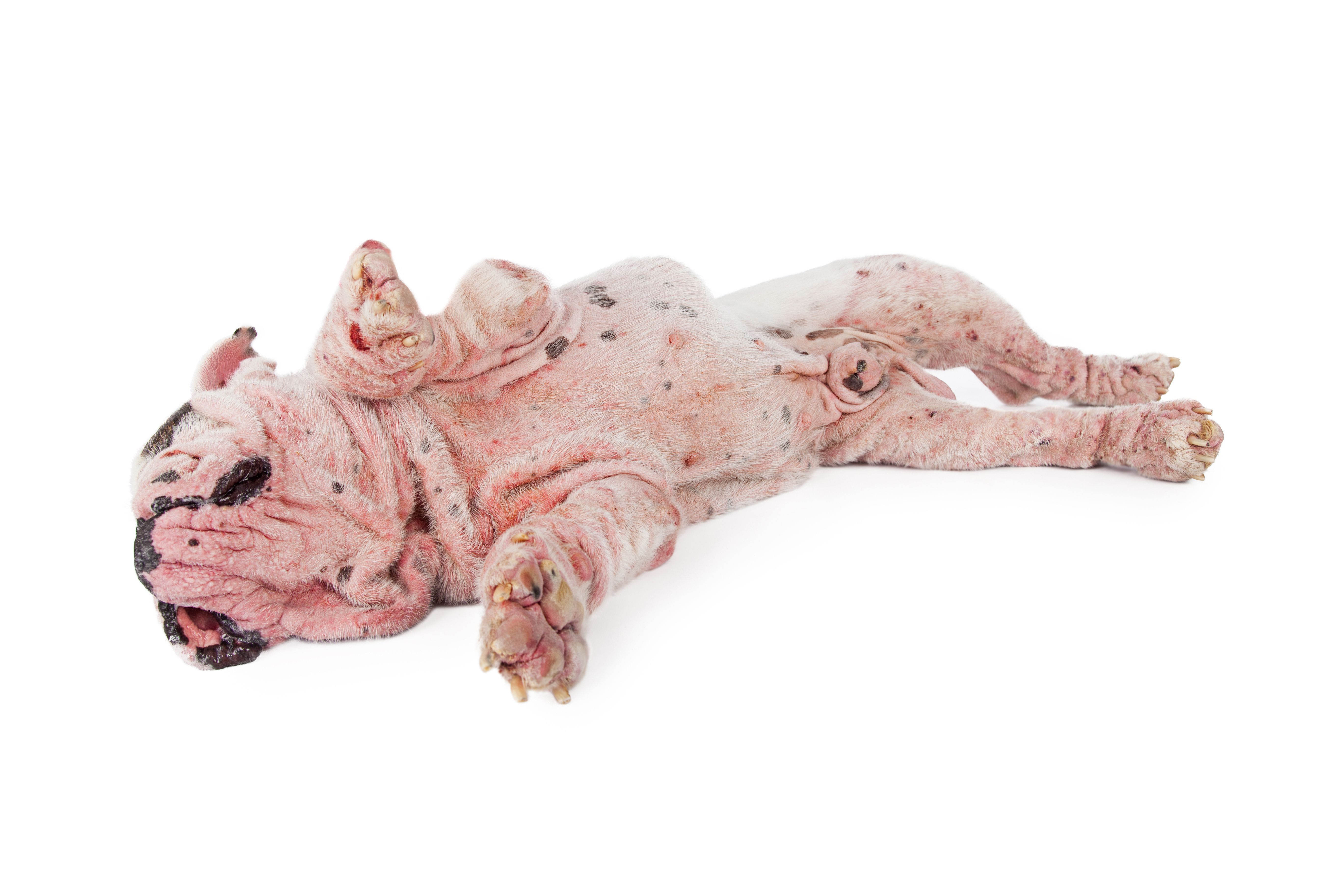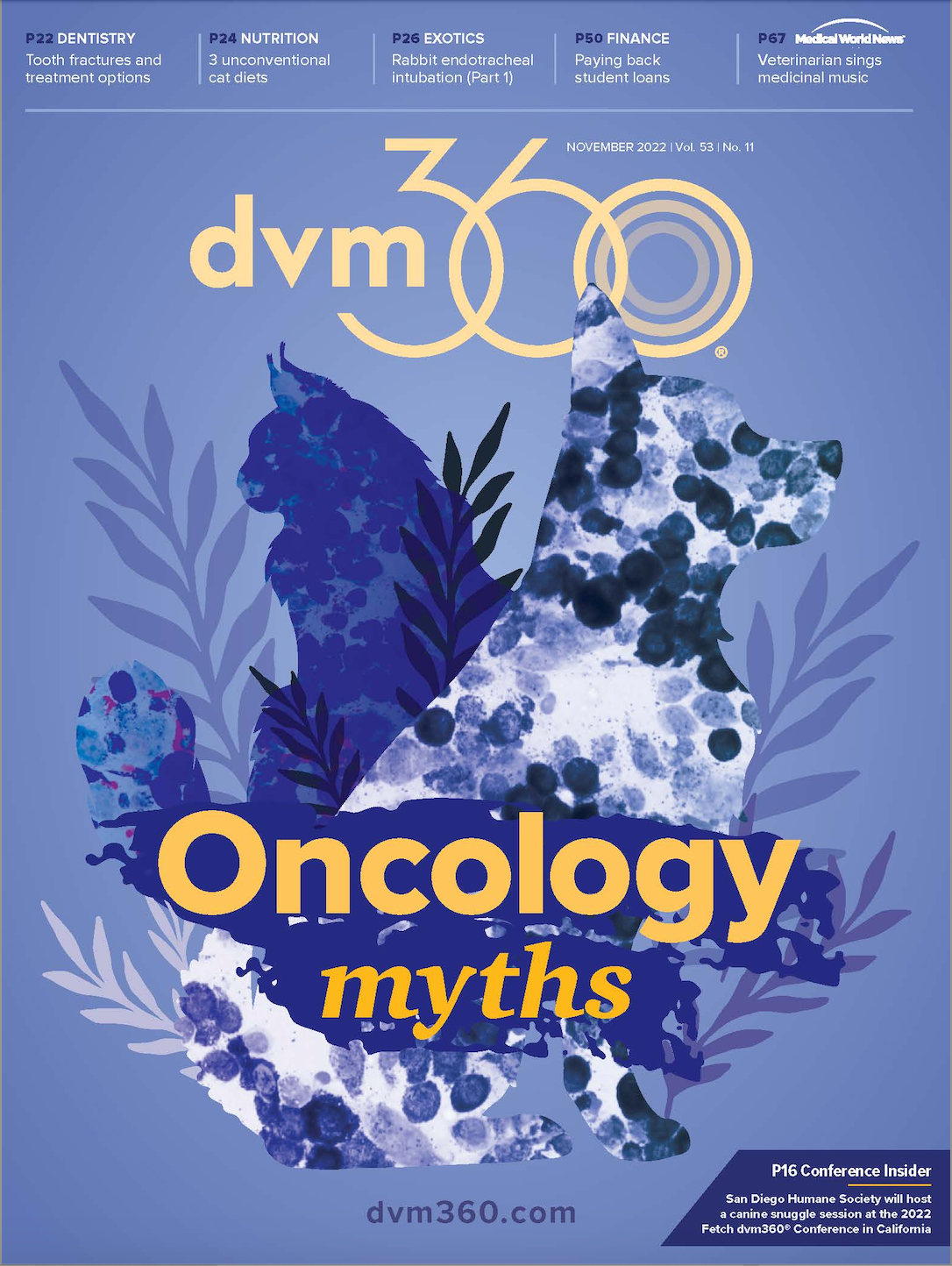Topical therapies in veterinary dermatology
Deciding which of the available products to carry in a clinic can be a challenge
The use of topical therapies in pets can be grouped around 4 main goals: treat infections and prevent their recurrence, decrease seborrhea or greasy skin texture, treat or prevent pruritus, and improve the skin barrier. Each of these goals and the treatments used to achieve them will be considered individually in the following sections.
Treat infections and prevent recurrence
Bacteria and yeast infections on the skin are a common dermatological concern. Superficial infections are ideally treated with topicals alone, and maintenance use of antimicrobial or antifungal agents can help prevent infection recurrence.1,2 Generally, shampoos can be applied 1 to 2 times weekly to treat infection, and 2 to 4 times monthly to prevent infection recurrence. Topicals such as sprays, wipes, or mousses can be used up to once or twice daily until the infection is resolved, then every 2 to 3 days to prevent recurrence.
adogslifephoto / stock.adobe.com

- Chlorhexidine is an antimicrobial and antifungal product that is usually present in 2% to 4% concentrations. It is broadly antimicrobial and has antifungal efficacy against Malassezia pachydermatis and common dermatophytes.3-5 Chlorhexidine causes cell death through destabilization of the cell walls, leading to cell content leakage.6 It is synergistic with azole antifungals,3,7 and has been found to have residual activity on hair for 7 to 10 days.8,9
- Azole antifungals include miconazole, ketoconazole, and climbazole, and are often combined with chlorhexidine.3 Azoles inhibit the synthesis of ergosterol, a key component of fungal cell membranes, leading to impaired cell wall composition, increased cell permeability, and cell death.10 Azole resistance is a potential growing concern,5,11 so this topic should be monitored to determine whether it continues to be appropriate to use azoles as preventives.
- TrisEDTA is composed of tromethamine (Tris) and ethylenediaminetetraacetic acid (EDTA). EDTA primarily causes damage to gram-negative bacterial cell walls, facilitating drug penetration, and Tris is a buffer that enhances the effects of EDTA.3 TrisEDTA has been reported to be synergistic with chlorhexidine in the treatment of Staphylococcus and Streptococcus species,3,12 and is present in many common topical products.
- Mupirocin is a topical antibiotic cream. It inhibits bacterial protein synthesis and has historically been effective against localized methicillin-resistant Staphylococcal infections.3 However, its frequent use is no longer recommended because of increased bacterial resistance to this antibiotic and the desire to reduce the use of antibiotics generally.1,2
Decrease seborrhea
Seborrhea is a defect in keratinization, the end step in skin cell differentiation, that leads to increased surface scale and a greasy texture to the skin.13 Seborrhea is commonly accompanied by pruritus and secondary pyoderma. Antiseborrheic treatments are designed to reduce the excess greasiness and scale and to flush hair follicles to remove built up debris.13 Treatments are divided into 2 categories: keratoplastic agents, which slow skin cell turnover to reduce scale production, and keratolytic agents, which increase skin cell shedding to prevent buildup. Many treatments have both keratoplastic and keratolytic properties.13
- Benzoyl peroxide is a follicular flushing and keratolytic agent.3 It is metabolized to benzoic acid in the skin, which breaks the connections between cells in the stratum corneum, the outermost skin layer.3 Benzoyl peroxide can help treat patients with blocked hair follicles and severe scale, but it is also extremely drying and can cause contact reactions in some patients.3 Therefore, use of benzoyl peroxide is recommended only for a few weeks, and it should be followed with a moisturizing conditioner to reduce dryness.
- Selenium sulfide at 1% concentration is found in the human dandruff shampoo Selsun blue, as well as several veterinary shampoos. It is both keratoplastic and keratolytic through interference with hydrogen bond formation by keratin in the stratum corneum.13
- Salicylic acid is mainly keratoplastic at low concentrations (0.1%-0.2%) and gains keratolytic effects at 3% to 6% concentrations.13 Salicylic acid is often found in combination with antimicrobials in pet shampoos, so use of these products could be considered in pets with both pyoderma and seborrhea.
Control pruritus
The purpose of antipruritic topical treatments is to temporarily relieve mild, usually localized itching. It is crucial to also identify and treat the underlying cause of the pruritus.
- Topical glucocorticoids effectively reduce acute flares of local inflammation and pruritus,14 such as hot spots or inflammation of interdigital spaces on the paws. However, longer-term use leads to topical and systemic adverse effects.14,15 Topically, common adverse effects include thinned and easily torn or bruised skin, pinnal curling in cats, increased skin scaling or flakiness, hair loss, comedones (blackheads), and secondary pyoderma due to immune suppression.15,16 The speed of topical and systemic adverse effects depends on the steroid and the medication vehicle,15,16 so more potent steroids in vehicles that increase their absorption will cause adverse effects to occur faster. More potent topical steroids include betamethasone, triamcinolone acetonide, mometasone, and fluticasone.15,16
- Topical anesthetics, such as pramoxine hydrochloride, numb local peripheral nerves and can be found in veterinary and human products including Neosporin + Pain Relief, Relief Shampoo, and Pramoxine Anti-Itch Shampoo.17 Pramoxine hydrochloride’s effects often last only a few hours, requiring multiple reapplications per day for a significant impact.17
Improve the skin barrier
Allergic patients’ skin barriers are altered in many ways, so the goal of treating the skin barrier in allergy is to try to supply missing nutrients and return the barrier to normalcy.14,18
- Ceramides are a crucial structural component of lipids in the stratum corneum, along with several other functions, and their levels are reduced in allergic patients’ skin.19 Ceramide complexes are present in many topicals for pets, including shampoos, sprays, and mousses. They are also present in a human over-the-counter lotion, CeraVe, which can be used as an economical, easy-to-find leave-on lotion for pets with dry skin.
- Oatmeal is a demulcent and a humectant, meaning that it both coats the skin to retain moisture and attracts more hydration into the skin.19 It is useful for soothing irritated skin in allergic patients, or adding moisture to the skin for patients with keratinization defects or autoimmune diseases.
- Plant extracts used to improve the skin barrier are usually plant-derived lipids. They have been found in data from some studies to be absorbed into the skin to normalize lipid levels in allergic patients,14,19 and are available in spot-on and shampoo formulations. However, there does not appear to be a benefit to topical lipids in patients that are also receiving oral fatty acid supplementation.14
In summary
There are so many topical products available for pets that it can be difficult to decide what to carry in a clinic. Multiuse products are usually easiest to carry. Examples include combination antimicrobial/antifungal shampoos or antiseborrheic shampoos that are also moisturizing or antipruritic. If you have questions about specific products, it is always appropriate to contact your local veterinary dermatologist for their opinion and to ask the product’s manufacturer for supporting research information.
Alexandra Gould, DVM, DACVD, is a dermatologist and the owner of Pet Dermatology Partners in Seattle, Washington. She graduated with honors from the University of Florida College of Veterinary Medicine in Gainesville and completed her residency training with Kimberly Coyner, DVM, DACVD, in Lacey, Washington, and Ann Trimmer, DVM, DACVD, in Las Vegas, Nevada. Her special interests include the management of immune-mediated skin diseases and allergies in dogs and cats.
References
- Hillier A, Lloyd DH, Weese JS, et al. Guidelines for the diagnosis and antimicrobial therapy of canine superficial bacterial folliculitis (Antimicrobial Guidelines Working Group of the International Society for Companion Animal Infectious Diseases). Vet Dermatol. 2014;25(3):163-e43. doi:10.1111/vde.12118
- Morris DO, Loeffler A, Davis MF, Guardabassi L, Weese JS. Recommendations for approaches to methicillin-resistant staphylococcal infections of small animals: diagnosis, therapeutic considerations and preventative measures: clinical consensus guidelines of the World Veterinary Association for Veterinary Dermatology. Vet Dermatol. 2017;28(3):304-e69. doi:10.1111/vde.12444
- Mendelsohn C, Rosenkrantz W. Dermatologic therapy. In: Miller WH Jr, Griffin CE, Campbell KL, eds. Muller and Kirk’s Small Animal Dermatology. 7th ed. Elsevier; 2013:124-127.
- Moriello KA, Coyner K, Paterson S, Mignon B. Diagnosis and treatment of dermatophytosis in dogs and cats. Clinical consensus guidelines of the World Association for Veterinary Dermatology. Vet Dermatol. 2017;28(3):266-e68. doi:10.1111/vde.12440
- Bond R, Morris DO, Guillot J, et al. Biology, diagnosis and treatment of Malassezia dermatitis in dogs and cats Clinical Consensus Guidelines of the World Association for Veterinary Dermatology. Vet Dermatol. 2020;31(1):28-74. doi:10.1111/vde.12809
- Ohta S. Kuroruhekishijin taisei kin no taisei kikō no kaimei (dai 2-pō) kuroruhekishijin taisei kin no saibō maku no kagaku seibun to saibō hyōsō no denshi kenbikyō-teki kansatsu. Abstract in English. Yakugaku Zasshi. 1990;110(6):414-425. doi:10.1248/yakushi1947.110.6_414
- Clark SM, Loeffler A, Bond R. Susceptibility in vitro of canine methicil-lin-resistant and-susceptible staphylococcal isolates to fusidic acid, chlorhexidine, and miconazole: opportunities for topical therapy of canine superficial pyoderma. J Antimicrob Chemother. 2015;70(7):2048-2052. doi:10.1093/jac/dkv056
- Ramos SJ, Woodward M, Hoppers SM, Liu CC, Pucheu-Haston CM, Mitchell MS. Residual antibacterial activity of canine hair treated with five mousse products against Staphylococcus pseudintermedius in vitro. Vet Dermatol. 2019;30(3):183-e57. doi:10.1111/vde.12737
- Mesman ML, Kirby AL, Rosenkrantz WS, Griffin CE. Residual antibacterial activity of canine hair treated with topical antimicrobial sprays against Staphylococcus pseudintermedius in vitro. Vet Dermatol. 2016;27(4):261- e61. doi:10.1111/vde.12318
- Ghannoum MA, Rice LB. Antifungal agents: mode of action, mechanisms of resistance, and correlation of these mechanisms with bacterial resistance. Clin Microbiol Rev. 1999;12(4):501-517. doi:10.1128/CMR.12.4.501
- Kano R, Kamata H. Miconazole-tolerant strains of Malassezia pachy- dermatis generated by culture in medium containing miconazole. Vet Dermatol. 2020;31(2):97-101. doi:10.1111/vde.12805
- Cavana P, Peano A, Petit J, et al. A pilot study of the efficacy of wipes containing chlorhexidine 0.3%, climbazole 0.5% and Tris-EDTA to reduce Malassezia pachydermatis populations on canine skin. Vet Dermatol. 2015;26(4):278-e61. doi:10.1111/vde.12220
- Miller WH Jr, Griffin CE, Campbell KL. Keratinization defects. In: Miller WH Jr, Griffin CE, Campbell KL, eds. Muller and Kirk’s Small Animal Dermatology. 7th ed. Elsevier; 2013:630-646.
- Olivry T, DeBoer DJ, Favrot C, et al; International Committee on Allergic Diseases of Animals. Treatment of canine atopic dermatitis: 2015 updated guidelines from the International Committee on Allergic Diseases of Animals (ICADA). BMC Vet Res. 2015;11:210. doi:10.1186/s12917-015-0514-6
- Mendelsohn C, Rosenkrantz W. Dermatologic therapy. In: Miller WH Jr, Griffin CE, Campbell KL, eds. Muller and Kirk’s Small Animal Dermatology. 7th ed. Elsevier; 2013:127-129.
- Reusch CE. Glucocorticoid therapy. In: Feldman EC, Nelson RW, Reusch C, Scott-Moncrieff JC, eds. Canine and Feline Endocrinology. 4th ed. Saunders; 2015:555-578.
- Mendelsohn C, Rosenkrantz W. Dermatologic therapy. In: Miller WH Jr, Griffin CE, Campbell KL, eds. Muller and Kirk’s Small Animal Dermatology. 7th ed. Elsevier; 2013:123-124.
- Santoro D, Marsella R, Pucheu-Haston CM, Eisenschenk MN, Nuttall T, Bizikova P. Review: pathogenesis of canine atopic dermatitis: skin barrier and host-micro-organism interaction. Vet Dermatol. 2015;26(2):84-e25. doi:10.1111/vde.12197
- Santoro D. Therapies in canine atopic dermatitis: an update. Vet Clin North Am Small Anim Pract. 2019;49(1):9-26. doi:10.1016/j.cvsm.2018.08.002
